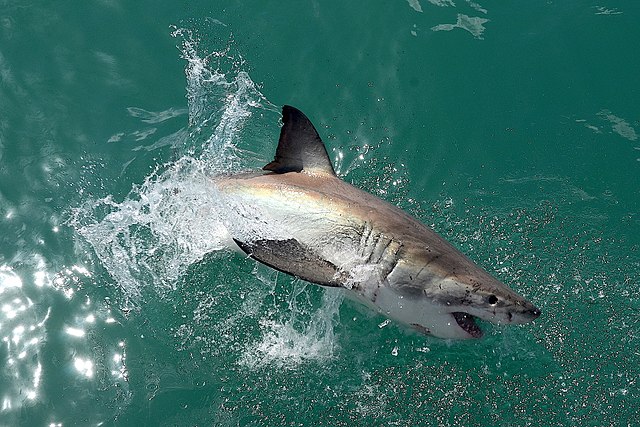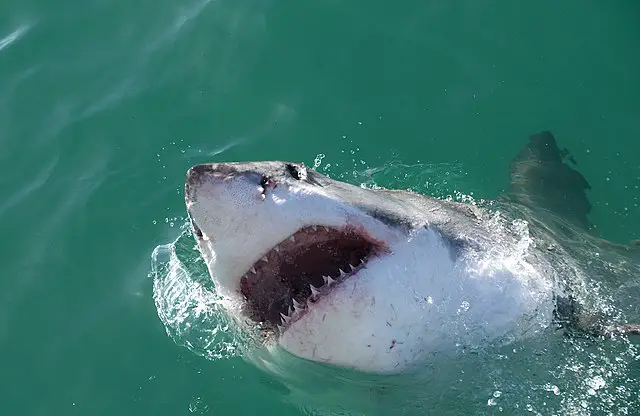Great white sharks grow to be about half the size of a school bus. They are some of the largest and most powerful creatures in the ocean.
Let’s dive deep to learn more about one of the ocean’s deadliest predators.
What do great white sharks look like?
Great whites grow to an average of 15 feet in length. Some great white sharks have been recorded as being over 20 feet long and weighing more than 5,000 pounds.

That makes great white sharks the world’s largest predatory fish. The two fish that are larger (the whale shark and the basking shark) eat plankton and are not predators.
They have torpedo-shaped bodies and a crescent-shaped tail fin. Their eyes are pitch black.
Great white sharks have grey bodies and white bellies. Their powerful tails can help them push through the water at speeds up to 15 miles per hour.
The great white shark’s mouth is lined with up to 300 sharp, triangular teeth in multiple rows.
Where do great white sharks live?
Great white sharks have one of the largest geographic ranges of any marine animal. That means they live all over.
They can be found in cool, coastal oceans around the globe. People used to think they only lived close to the coast, but they have also been sighted in the open ocean.

Great whites are migratory and often travel long distances every year. In the Pacific, they migrate between Mexico and Hawaii. In other oceans, some great whites migrate even greater distances.
What do great white sharks eat?
The great white shark is an aggressive predator who eats sea lions, seals, small toothed whales, carrion, sea turtles, and smaller fish like halibut.
Great white sharks are well equipped for hunting and even have organs that detect the small electromagnetic fields generated by animals. This helps them find their prey more easily.
Although great white sharks have up to 300 teeth, they don’t chew their food. Instead, they rip their prey into mouth-sized pieces which are swallowed whole.
Great White Shark Behavior
Great whites usually hunt alone, but they can also be social creatures. Scientists have observed that sharks may spend significantly more time with some sharks than with others, indicating friendship or bonding.
They are sometimes seen in pairs or even small groups feeding on other animals. They can feed on other animals together without becoming aggressive toward one another. Usually, the largest or most dominant shark feeds first.

Great whites have even been seen to work together while hunting. For example, one shark might distract a seal while another swims from behind and grabs it.
Female great whites give birth to live young who are over three feet long and weigh up to 60 pounds. She usually has two to ten babies, called “pups.”
Mothers and fathers do not bond with their young and may even try to eat them. Once born, the great white swims off on its own.
The young great whites are already natural predators who begin feeding on coastal fish before moving on to larger prey.
Great whites are often considered dangerous to humans, but attacks on humans are extremely rare. There are around 5-10 attacks a year.
Scientists think they take “sample bites” then swim off once they realize people are not their preferred prey. Unfortunately, because of the size and power of great whites, one bite can be extremely painful or even deadly.
Are great white sharks endangered?
Experts don’t have an accurate estimate of how many great white sharks are left, but the number is probably in the hundreds or low thousands.
Although great white sharks are spread throughout the world, there’s no large population anywhere. It’s clear that their numbers are decreasing.
They are not endangered, but they are considered vulnerable to extinction. Humans are the greatest threat to the great white shark. They have been hunted for fins, teeth, and as trophies for sport fishing.
Another danger to sharks is gill nets, which often entangle and accidentally trap them. Additionally, sharks are sometimes caught on accident by commercial fishing operations.
Other Interesting Facts About Great White Sharks
- Great whites have such a strong sense of smell that they can smell a colony of seals from two miles away. They can also detect a single drop of blood in 25 gallons of water.
- Most sharks are cold-blooded, but the great white is warm-blooded. Like all sharks, great whites have no true bones.
- Of about 100 shark attacks that occur each year, 1/3 to 1/2 come from great whites. Most of the bites are not fatal.
- The great white shark’s scientific name is Carcharodon carcharias, which means “sharp teeth.”
- The average lifespan of a great white shark is estimated to be over 30 years.
- In 2019, a great white shark in Taiwan was found to be pregnant with a record-breaking 15 pups.